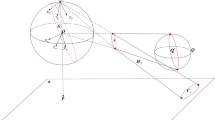Abstract
The traditional calibration paradigms fail to give reliable and accurate results in case of low-quality 2D planar calibration plates. In this paper, an active method is proposed by employing an LCD panel for camera calibration. This method automatically generates a sequence of virtual patterns in different views by pre-defined transforms without manually manipulation or other equipment’s help to move the patterns. Then, the projections of virtual patterns are captured by a camera. The homography between projective patterns in virtual world coordinate and their images is calculated directly to obtain the camera parameters. Experimental results show that the calibration error is 0.018 pixel in terms of mean re-projection error by using 18 virtual patterns, which is significantly less than the state-of-the-art methods. The proposed scheme makes camera calibration flexible and easy to use.












Similar content being viewed by others
References
Tsai R (1987) A versatile camera calibration technique for high-accuracy 3D machine vision metrology using off-the-shelf TV cameras and lenses. IEEE Conf Comput Vis Pattern Recognit 3(4):323–344
Da F, Gai S (2008) Flexible three-dimensional measurement technique based on a digital light processing projector. Appl Opt 47(3):377–385
Henry P, Krainin M, Herbst E, Ren X, Fox D (2013) RGB-D mapping: using depth cameras for dense 3D modeling of indoor environments. Int Symp Exp Robot 31:647–663
Zhang Z, Han Y, Zhou Y, Dai M (2013) A novel absolute localization estimation of a target with monocular vision. Optics 124(12):1218–1223
Liu W, Shi W, Lv Y, Cao J et al (2013) A novel method of camera pose estimation by parabolic motion. Optics 124(24):6840–6845
Lv Y, Feng J, Li Z, Liu W, Cao J (2015) A new robust 2D camera calibration method using RANSAC. Optics 126(24):4910–4915
Cyganek B, Paul Siebert J (2011) An introduction to 3D computer vision techniques and algorithms. Wiley, Hoboken
Hartley R, Zisserman A (2000) Multiple view geometry in computer vision, 2nd edn. Cambridge University Press, Cambrige
Ma Y, Vidal R, Kosecka J, Sastry S (2000) Kruppa equation revisited: its renormalization and degeneracy. In: Proceedings of the European conference on computer vision, pp 561–577
Maybank S, Faugeras O (1992) A theory of self-calibration of a moving camera. Int J Comput Vis 8(2):123–151
Wang G, Tsui H, Hu Z, Wu F (2005) Camera calibration and 3D reconstruction from a single view based on scene constraints. Image Vis Comput 23(3):311–323
Triggs B (1997) Auto-calibration and the absolute quadric. In: CVPR, Puerto Rico, vol 22, no 8, pp 609–614
Chen W, Du J, Xiong W, Wang Y, Chia S, Liu B, Cheng J, Gu Y (2018) A noise-tolerant algorithm for robot-sensor calibration using a planar disk of arbitrary 3-D orientation. IEEE Trans Autom Sci Eng 15:251–263
Heikkila J, Silven O (1997) A four-step camera calibration procedure with implicit image correction. CVPR 22:1106–1112
Zhang Z (2000) A flexible new technique for camera calibration. IEEE Trans Pattern Anal Mach Intell 22:1330–1334
Escalera ADL, Armingol JM (2010) Automatic chessboard detection for intrinsic and extrinsic camera parameter calibration. Sensors 10:2027–2044
Heikkila J (2000) Geometric camera calibration using circular control points. Pami 22(10):1066–1077
Liu Z, Wei X, Zhang G (2013) External parameter calibration of widely distributed vision sensors with non-overlapping fields of view. Opt Laser Eng 51:643–650
Zhang Z (2004) Camera calibration with one-dimensional objects. IEEE Trans Pattern Anal Mach Intell 26(7):892
França JAD, Stemmer MR, França MBDM, Piai JC (2012) A new robust algorithmic for multi-camera calibration with a 1D object under general motions without prior knowledge of any camera intrinsic parameter. Pattern Recognit 45(10):3636–3647
Douterloigne K, Goeman W, Gautama S, Philips W (2013) Automatic detection of a one dimensional ranging pole for robust external camera calibration in mobile mapping. ISPRS J Photogramm Remote Sens 86:111–123
Zhou F, Cui Y, Wang Y, Liu L, Gao H (2013) Accurate and robust estimation of camera parameters using RANSAC. Opt Lasers Eng 51(3):197–212
Zhang Q, Wu S, Wang W, Fang Z (2017) Improving 2D camera calibration by LO-RANSAC. Int J Inf Electron Eng 7:93–98
Song Z, Chung R (2008) Use of LCD panel for calibrating structured-light-based range sensing system. IEEE Trans Instrum Meas 57(11):2623–2630
Zhan Z (2008) Camera calibration based on liquid crystal display (LCD). XXXVII ISPRS Congress. Commission III, pp 1682–1750
Tan L, Wang Y, Yu H, Zhu J (2017) Automatic camera calibration using active displays of a virtual pattern. Sensor 17(4):685–697
Ren M, Liang J, Wei B, Pai W (2017) Novel projector calibration method for monocular structured light system based on digital image correlation. Optik Int J Light Electron Opt 132:337–347
Acknowledgements
This work was supported in part by National Natural Science Foundation of China under Grant Numbers 61775172, 61371190 and 51805381. The authors wish to acknowledge the anonymous reviewers’ insightful and inspirational comments that have greatly helped to improve the technical contents and readability of this paper.
Author information
Authors and Affiliations
Corresponding author
Additional information
Publisher's Note
Springer Nature remains neutral with regard to jurisdictional claims in published maps and institutional affiliations.
Rights and permissions
About this article
Cite this article
Jiang, J., Zeng, L., Chen, B. et al. An accurate and flexible technique for camera calibration. Computing 101, 1971–1988 (2019). https://doi.org/10.1007/s00607-019-00723-6
Received:
Accepted:
Published:
Issue Date:
DOI: https://doi.org/10.1007/s00607-019-00723-6




